INDIAN ARMED FORCES CHIEFS ON
OUR RELENTLESS AND FOCUSED PUBLISHING EFFORTS

SP Guide Publications puts forth a well compiled articulation of issues, pursuits and accomplishments of the Indian Army, over the years

I am confident that SP Guide Publications would continue to inform, inspire and influence.

My compliments to SP Guide Publications for informative and credible reportage on contemporary aerospace issues over the past six decades.
A Peek into the Future
Aviation continues to change at an astonishing pace driven by factors that lie at the core of aviation. Future aviation hinges on design, speed and alternative fuels.

Change is constant. It envelops all fields, aviation included. It continues to change at an astonishing pace driven by factors that lie at the core of aviation. The evolution of the aerospace industry has been staggering, from the first plane designed and developed by the Wright brothers to now. It continues to change at an astonishing pace driven by factors that lie at the core of aviation. These are as follows:
- Design: First is the design. While the basic concept of an aircraft remains, the design has undergone a sea change.
- Speed: The next factor is speed. From 10.98 kmph of the Wright Flyer to unbelievable speed of 10,461 kmph or 8.4 times faster than the speed of sound, achieved by the National Aeronautics and Space Administration (NASA) X-43A, an unmanned experimental hypersonic aircraft, fastest aircraft ever built, speed continues to thrill.
- Fuel: Considering the pressure on the aviation industry due to high cost of aviation turbine fuel (ATF), engineers and scientists are relentlessly pursuing work in the direction of alternative fuels, better fuel efficiency and improved performance.
- Avionics: Communications, navigation, display and management of multiple systems have changed rapidly in sync with the needs of both the operator and the end-user. The key is user-friendly avionics.
Design Dazzle
Blended Wing Body
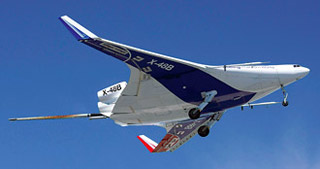
Boeing Phantom Works has partnered with NASA and the US Air Force Research Laboratory to study the structural, aerodynamic and operational advantages of the blended-wing body (BWB) concept, a cross between a conventional plane and a flying wing design. The 8.5 per cent scale, remotely piloted X-48B is dynamically scaled to fly much like the full-size aircraft would fly. The X-48B BWB demonstrator is an experimental aircraft with potential tanking, weapons carriage as also command and control applications. It eliminates the conventional tail rudder and has 20 control surfaces on the trailing edge, including ailerons and elevons, as well as rudders on the winglets. The innovative design allows for less drag which translates to reduced fuel consumption. And because the engines mount high on the back of the aircraft, there is less noise inside. The BWB is more than an idea. It’s an experimental aircraft in active testing and has the potential to change the course of aviation.
In 2010, at the Farnborough International Airshow, Airbus unveiled a ‘Concept Plane’ that illustrated what air transport could look like in 2050, even 2030, if advances in existing technologies continue apace. Airbus experts in aircraft materials, aerodynamics, cabins and engines came up with the concept plane, an “engineer’s dream”. It brings together a package of technologies that are unlikely ever to coexist in such a manner. It is not a plane intended to fly—it is a representation of the main technological fields that are being explored to fulfil future needs: a significant cut in fuel burn, less noise and greater comfort. The design comprised ultra long and slim wings, semiembedded engines, a U-shaped tail and lightweight “intelligent” body, features that will improve environmental performance.
New Aircraft Concepts
The European Union’s New Aircraft Concepts Research (NACRE) project in which Airbus is an industry partner is studying potential radical overhauls to aircraft design with the goal of improving eco-efficiency, optimising performance and reducing costs. Within this effort, the NACRE Pro Green aircraft specifically aims at the reduction of an airliner’s operational environmental footprint. It features an un-swept wing with a high span that reduces induced and friction drag due to natural laminar flow. The engines are mounted on top of the rear fuselage above a U-tail, in a way that noise emissions are shielded by the wing and the tail. The engines’ very large fan diameter is optimised for slow jet speeds in order to improve fuel efficiency and decrease noise.
The design range of the NACRE Pro Green aircraft concept is relatively short in order to reduce the overall gross weight and is designed for lower cruise altitudes, so that the exhaust emissions will be washed out from the atmosphere with the troposphere’s thermal convection. It will use drop-in fuel with similar properties as kerosene, possessing high energy density, enabling lowest energy consumption.
Terafugia is Street-legal
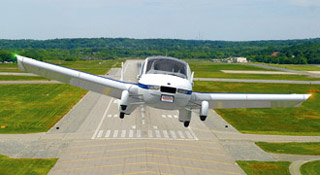
Terrafugia’s Transition, a small airplane that doubles as a street-legal automobile, needs to be closely watched as it is going to transform city living. The company says it can switch between flying and driving modes in less than a minute, and despite a 26.6-ft. wingspan, can fit in a one-car garage thanks to its electro-mechanically folding wings. The Transition has the distinction of being the only light aircraft designed to meet the US Motor Vehicle Safety Standards and the only car equipped with a full-vehicle parachute. It tops out at 160 kmph in the air with a range of about 640 km. On the highway, the Transition manages decent fuel economy with 56 km per gallon. The price of Terrafugia is about $2,80,000 and the company believes it will find a niche with practical benefits eliminating the need for ground transportation to and from an airport.
NASA Showcases Future Aircraft
NASA has tried to envisage a future aircraft of 2025, revealing some examples of how a new, modern, innovative and eco-friendly aircraft should look like. Some design changes are visible from the first glance. The simulated models look ultramodern, amazing and awe-inspiring. However, it is not the only external changes that NASA has tackled. For example, in the future we may see ultra-modern shaped memory alloy, ceramic or fibre composites, carbon nano-tubes or fibre-optic cabling, self-healing skin, hybrid electric engines, folding wings, double fuselages and virtual reality windows.
Blended-Wing Body Concept
It’s the right shape and form that helps save fuel. The draft plane of the German Aerospace Centre blends cabin with wings to create a blended-wing body (BWB). This reduces resistance and the cabin itself becomes part of the wings. Boeing too has come up with the X-48B BWB demonstrator with potential for a variety of applications.
Fuel Matters
With the price of crude going past $100 per barrel and continuing to move upwards, the pressures on the airline industry are wreaking havoc. Accounting for between 30 and 40 per cent of the operating costs of an airline, efforts are on to improve fuel efficiency and to come up with alternative energy systems, including as unbelievable as planes running on a mixture of batteries, body heat and cow manure. Some scientists are seriously working on that.
Designs from the Boeing stable
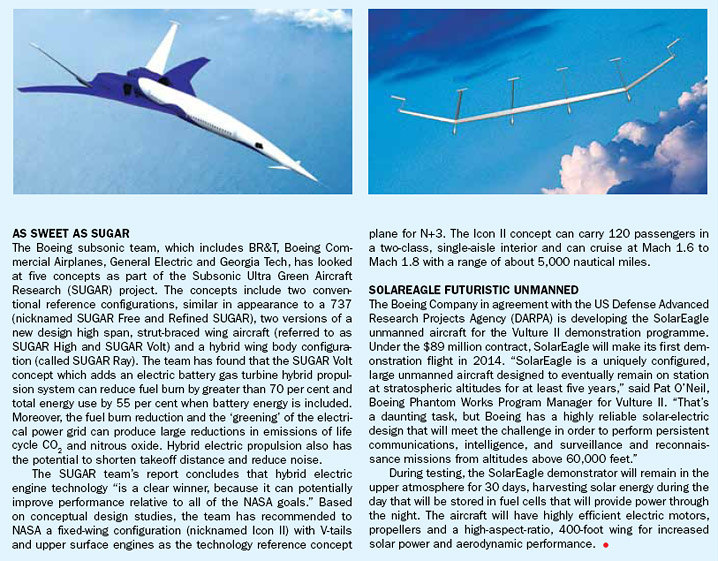
Greener Aviation
Sustainable practices are changing the way we live, transportation is no exception. Eco-friendly concepts are determining future aviation when it comes to design (use of composites and other eco-friendly materials); greener fuels and less noise emitting aircraft. In 2011, NASA assigned three industry teams which had to spend the entire year studying and looking for ways to make future aircraft burn 50 per cent less fuel than earlier aircraft that entered service in 1998 as well as to discard 75 per cent fewer harmful emissions and shrink the size of geographic areas affected by undesirable airport noise by 83 per cent. Alternative fuels are coming up on the horizon and most likely will replace traditional jet fuels. Bio-derived fuels, methanol, ethanol, liquid natural gas, liquid hydrogen and synthetic fuels are seen as future fuels. Scientists concur that these alternatives have a good potential in aviation, though all the experimentation is taking place in the realm of ground transportation for the simple reason that aircraft are not yet as fuel-flexible as ground vehicles are.
The German Aviation Centre which is working on aircraft efficiencies has come up with the idea of open rotors that are significantly more efficient than modern jet engines. Research has indicated that this new concept enables saving of fuel up to 20 per cent. The rotors can measure as much as five metres in diameter.
XCOR’s Lynx
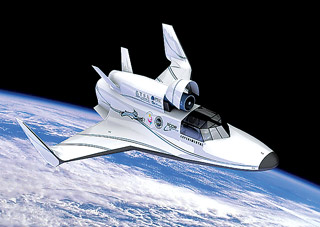
XCOR is pioneering the idea of point-to-point space travel: crossing the planet by leaving it altogether. It hopes to make it a reality by 2030, and the first step is getting a “stepping stone vehicle” into space.
The two-seater Lynx will take off and land on a runway like a conventional plane, but will fly outside the atmosphere, fast enough to get from London to Sydney in three-and-a-half hours. The Lynx is XCOR’s entry into the commercial reusable launch vehicle (RLV) market. This two-seat, piloted space transport vehicle will take humans and payloads on a half-hour suborbital flight to 100 km (3,30,000 feet) and then return safely to a landing at the takeoff runway.
Like an aircraft, Lynx is a horizontal take-off and horizontal landing vehicle, but instead of a jet or piston engine, Lynx uses its own fully reusable rocket propulsion system to depart a runway and return safely. This approach is unique compared to most other RLVs in development, such as conventional vertical rocket launches and air-launched winged rocket vehicles “dropped” at altitude from a jet powered mother ship.
XCOR is booking “up and down” flights in the Lynx for $95,000. Once it has built up a reliable safety record, it will develop and launch a larger spacecraft that will make point-topoint space travel a reality.
Body Heat into Electrical Energy
University Putra Malaysia has presented another novel energysaving technology involving converting passengers’ body heat into electrical energy. Tan Kai Jun from the university envisions cabin seats upholstered with a thermoelectric fabric that can convert a person’s body heat into 100 nanowatts of electrical energy. The energy produced is about one-millionth of what an iPhone needs to stay on standby. This is futuristic.”It’s a small amount, but imagines this collected from 550 seats throughout ten hours of flight. A plane has a lifespan of a few hundred flights. Over time that’s a big reduction,” Jun says.
New Materials
Monash University is working on very light; very strong new metals and emerging manufacturing processes that they believe are going to usher in a new era of aerospace technology. The university is keeping close to the technology that could make this laboratory the genesis of the next generation of aerospace manufacturing. The work is being done by Professor Xinhua Wu, recognised internationally as a leader in advanced light metals research. She is heading the Australian Research Council’s (ARC) Centre of Excellence for Design in Light Metals and aerospace majors such as Bombardier, Airbus, European Space Agency and Safran-Microturbo that are keenly following her research efforts.
Manufacturers are looking for new materials that are lighter yet stronger, cheaper to manufacture, reliably safe and which will also help them halve aviation’s overall carbon emissions by 2050. One of the centre’s projects is a new aluminium alloy that will make an aircraft 30-40 per cent lighter, twice as fuelefficient and still be structurally as strong.
Electricity to Get Off the Ground
Aviation contributes around three per cent to global emission of carbon dioxide. The EU commission is calling for a reduction by 25 per cent by 2050. Visionary new aviation projects could help realise this ambitious goal. And the plane built by Bauhaus-Luftfahrt uses electricity to get off the ground in its effort to reduce carbon footprint.
Solar-Impulse
Aviation pioneers Bertraind Picard and Andre Borschberg have demonstrated a plane which is geared towards efficiency with very long wings, a slender body and powered by electricity. The “Solar-Impulse” airplane is an amazing development, but only that the plane is limited to a speed of 70 kmph and can carry no cargo.
Scramjets - Europe to Australia in 90 minutes
For those always in a hurry, there are other options. The “Spaceliner” by the German Aviation Centre is a suborbital, hypersonic winged passenger plane with rocket engines. By 2050, it might be able to take you from Europe to Australia in a mere 90 minutes. Hypersonic engines or “scramjets” (supersonic combustion ramjet) would enable aircraft to travel coast-to-coast in the US in about 30 minutes and from London to Sydney in about 90 minutes. Scramjets operate at speeds in excess of five times the speed of sound and have a simple mechanical design with no moving parts.
Personal Air Vehicles
At NASA’s Langley Research Center in Virginia, researchers have been working on a different vision for the future of aviation. The Small Aircraft Transportation System (SATS) offers an alternative solution to the problem of burgeoning demand for air travel. SATS, its originators suggest, would divert pressure away from the “hub-and-spoke” model of air travel. NASA is designing new aircraft for the job: four- to eight-seater passenger jets and looking further to the future at personal air vehicles which it says would be affordable for the general public and self-operated without the need for a pilot.
EADS’ ZEHST
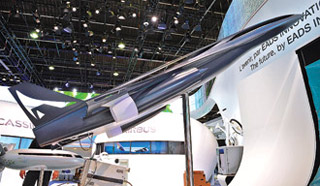
The Zero Emission Hyper Sonic Transport or ZEHST is a supersonic passenger airliner project by EADS and Japan. It can be seen as a descendant of the Concorde airliner. Unveiled on June 18, 2011, by EADS at Paris Air Show, it is projected to fly at Mach 4, 32 km above the ground, carrying 50-100 people. It would combine three propulsion systems: two turbofans for take-off and up to Mach 0.8, then rocket boosters up to Mach 2.5, then two under wing supersonic ramjets would accelerate it to Mach 4. The plane is envisaged to be propelled by biofuel made from seaweed and by oxygen/hydrogen. Using turbofans for takeoff would make ZEHST no noisier than currentday ordinary planes. ZEHST is envisaged to fly by 2050.
The ZEHST will fly 20 miles above the Earth, which EADS says is so high, the sonic boom will be inaudible from the ground. Travelling at more than Mach 4, it could cross the Atlantic in an hour and travel from Tokyo to Los Angeles in less than two and a half hours. It could fly from London to Japan in less than three hours.
Flying Commuters
Jet pack ideas abound such as the Martin Jetpack and Marc Newson’s “Body Jet” and flying cars are on the make. Examples are the Terrafugia and Moller International’s Skycar. Personal air commute is at least closer than it was before. The US Congress has ordered the Federal Aviation Administration to pave the way, legally and technically, for unmanned aircraft systems to fly in US airspace by 2015. Flying commuters can piggyback on those changes.
Pilotless Passenger Aircraft
The advancement of technology could soon mean that aircraft no longer need a pilot at the controls. The phrase “this is your captain speaking” may soon become a thing of the past, thanks to a new generation of robotic, passenger aircraft that will take to the skies by themselves. The next generation, such as the US Navy’s X-47B, will be even more advanced, with onboard intelligence that will allow it to adapt its course and fly with only minimal input from a pilot. BAE Systems recently flew a converted Jetstream aircraft—known as “The Flying Test Bed” —with no pilot in UK air space. The trial flights did have people on board, allowing a human to take control in an emergency. But for the large part, it flew itself.
NASA Working on D8
NASA researchers are working with industry and university partners to develop ideas for future airplanes that dramatically reduce noise, emissions and fuel consumption. One idea comes from a research team led by the Massachusetts Institute of Technology (MIT) in Cambridge and funded by a NASA grant. MIT and NASA engineers recently tested a 1/11th scale model version of the D8 in the 14 by 22-foot Subsonic Wind Tunnel at NASA’s Langley Research Center. The test was designed to produce data, now being analysed, that can determine whether incorporating the engines into the fuselage of the airplane actually reduces drag.
Lockheed Martin’s box wing concept
Lockheed Martin’s advanced vehicle concept proposes a box wing design, which is now feasible thanks to modern lightweight composite (non-metallic) materials, landing gear technologies and other advancements. Its Rolls-Royce Liberty Works Ultra Fan Engine achieves a bypass ratio (flow of air around engine compared to through the engine) nearly five times greater than current engines, pushing the limits of turbofan technology to maximise efficiency. This design is among those presented to NASA at the end of 2011 by companies that conducted NASAfunded studies into aircraft that could enter service in 2025.
Adoption of new technologies are going to be solely dependent on the core factors mentioned earlier, all wrapped into a ‘viable business’ initiative. But there is no doubt whatsoever that the pursuit of man to better from what exists, continues to give wings to dreams.





